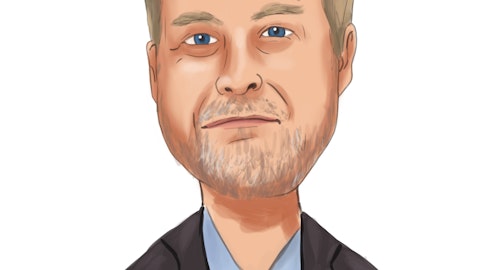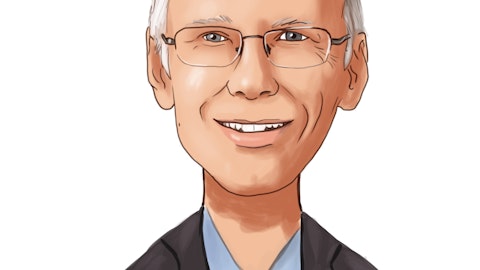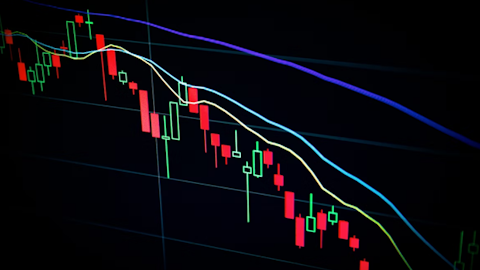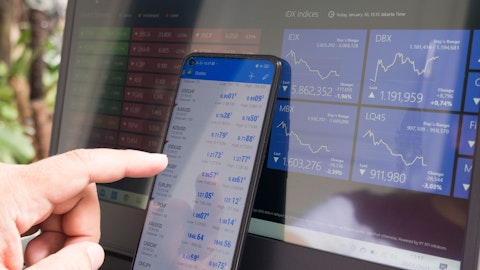Michael Sison: Sequential. Yes. And then, you gave guidance of $125 million EBITDA for the first quarter, implies you need a better second half. And I guess the second half improvement is really just driven by better volume versus anything else, meaning is there other things that could help drive that better second half besides better demand?
Bob Patterson: Yes. Well, I mean, I do think that one is we have taken some actions to reduce cost, which actually will start to kick in here in the second quarter. So that will actually have a greater effect in the second half than in the first half. I also think it just kind of remains to be seen how things play out from a raw material standpoint, but could see some benefit from that as well. But yes, if you look at how the quarters play out, I’d say it follows really some normal level of seasonality to the extent that this year is normal in that regard, but we’ll have to see, with some additional cost actions that help the back half of the year.
Michael Sison: Got it. Thank you.
Bob Patterson: Yes.
Operator: Thank you. Our next question comes from Mike Harrison with Seaport. Your line is open.
Mike Harrison: Hi. Good morning.
Bob Patterson: Hi.
Mike Harrison: Bob, I had a question on the composites business. The pro forma slide that you show says that it’s about a 25% EBITDA margin business for 2022. Is the plan to grow at that kind of mid-20%-s EBITDA margin? Or should we think of there being some operating leverage or price cost opportunity to get margins higher over time? Just kind of curious if you have an EBITDA margin target for composites longer term?
Bob Patterson: Longer term, it should be higher than 25%. And last year, in particular, our business in Europe was negatively impacted by higher energy costs, including the Dyneema business. And so that impacted margins in 2022. As energy costs abate here or at least flatten out, hopefully that becomes a little bit better comparable in ’23. But as you know, what we presented before on a pro forma basis, Dyneema is historically operated above that, and I really believe the same can be true for a balance of our composite businesses as well.
Mike Harrison: All right. And just curious with your leverage below 3 times, congratulations on the strong free cash flow and working capital management by the way, can you give some thoughts on how you’re thinking about capital allocation for 2023? Are you going to continue focusing on getting that variable rate debt paid down? Are you going to be looking at share repurchases? Maybe comment on whether the M&A market is getting more attractive? Any thoughts there would be helpful. Thanks.
Bob Patterson: Yes. I mean, first and foremost, we have some important investments that we want to make in the business to accommodate and capture some of the remaining Clariant synergies. As you know, there were some that we had delayed as a result of COVID and plan to effectuate those in this year. There’s additional investments that we’re planning to make to help actually drive growth for our composites. In some cases, we’re bumping into some capacity things that we’ll solve this year. And plus, I kind of view operating the business, obviously, is priority number one. And candidly, in terms of priorities thereafter, I think keeping that leverage below 3 times takes priority over share repurchases or anything else. We’d be looking to — every year, we’ve been increasing the dividend for the last 11 or 12 years. We hope that we could do that again next year, but that would be something we would announce sometime in the fourth quarter.
Mike Harrison: All right. Thank you very much.
Operator: Thank you. And our next question comes from Angel Castillo with Morgan Stanley. Your line is open.
Angel Castillo: Hi. Thanks for taking my question. I was hoping you could give us a little bit more color just on the order trends as they kind of — how it developed in January, February and just roughly what you’re seeing kind of in terms of early orders for March?
Bob Patterson: I mean right now, I don’t think there’s anything unique or special to highlight about what we’ve seen so far. It’s in line with what we’re projecting. As is typical for us though, March is typically a bigger month than the other two as we head into the second quarter. So, to some extent that, that is actually baked into our analysis as well. So, nothing really helps to report on January, specifically.
Angel Castillo: Got it. And then, you talked about some potential upside from deflation or just margin and the conservatism baked in there. Could you just, I guess, give us or help us quantify maybe what are the assumptions underlying your guidance in terms of raw materials, whether it’s energy prices or just basically what the assumptions are there? And then, also on the restructuring and savings front, what the kind of expected benefit of that is throughout the quarters?
Bob Patterson: Yes. Look from an energy standpoint — and I’m going to kind of give you a global view of this, okay? So, clearly, it varies by region, but total energy costs were up 35%. That was actually about $20 million in ’22 versus ’21. In fact, we probably could split that out on Slide 17 of this deck that we had that’s in the segments right now. We have energy costs going up about 6% in total for ’23 versus ’22. Obviously, that has some level of skewing here in the first half compared to last year. And then, we’ll see how that plays out in the second half. Obviously, right now I would say Europe is feeling a lot better with respect to getting through preponderance of this winter where energy storage are right now and hopefully that provides some relief in that region.
And then, look with respect to raw materials, and — we are, obviously, seeing some deflation as we go into this year. We’ve modeled a little bit of that. I really couldn’t put a quantification to it, but I would say that there is more opportunity there. And as I said in my prepared remarks, we’re just kind of balancing that with uncertainty around demand. So, we’ll see how that plays out in the next couple of months and hopefully can give some more clarity on that on our first quarter call.
Angel Castillo: Got it. And then, on the cost savings side?





